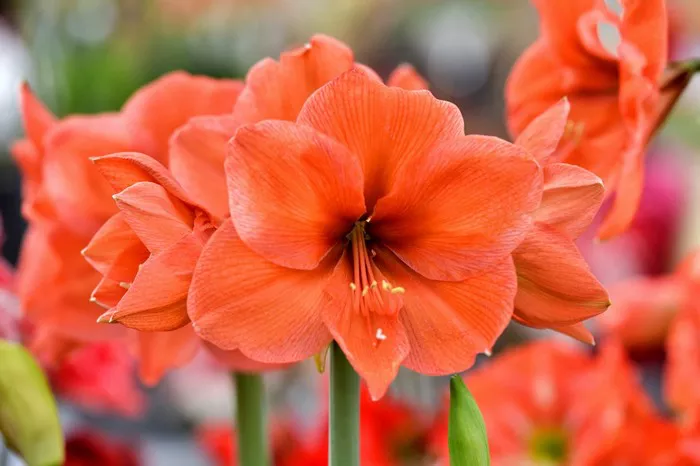Flowers have long been used as a means of communication, conveying emotions, sentiments, and messages through their colors, shapes, and fragrances. From expressing love and gratitude to conveying condolences and apologies, flowers play a significant role in human interaction and cultural traditions worldwide. One of the most intriguing aspects of floral symbolism is the meaning associated with different colors. Understanding what each color represents can help individuals choose the perfect floral arrangement to convey their intended message accurately.
Red Flowers: Passion, Love, and Desire
Red is perhaps the most iconic color when it comes to expressing love and passion. Red flowers, such as roses, tulips, and carnations, symbolize deep emotions, romance, and desire. They are often exchanged between partners on occasions like Valentine’s Day or anniversaries to express love and affection. Additionally, red flowers can signify courage, strength, and determination, making them suitable for celebrating achievements or offering support during challenging times.
White Flowers: Purity, Innocence, and New Beginnings
White flowers are associated with purity, innocence, and spirituality. They are often used in weddings to symbolize the purity of love and the beginning of a new chapter in life. White blooms like lilies, orchids, and daisies also convey a sense of peace, tranquility, and clarity. In times of mourning, white flowers are commonly chosen to express condolences and offer solace, representing the purity of the departed soul and the hope for eternal peace.
Yellow Flowers: Friendship, Joy, and Happiness
Yellow flowers radiate warmth, positivity, and happiness. They are often given to friends and loved ones to convey feelings of joy, friendship, and appreciation. Yellow blooms like sunflowers, daffodils, and tulips are perfect for celebrating milestones, expressing gratitude, or simply brightening someone’s day. Yellow flowers symbolize optimism, vitality, and renewal, making them ideal for occasions such as birthdays, graduations, or welcoming a new baby.
Pink Flowers: Affection, Gratitude, and Femininity
Pink flowers embody sweetness, affection, and femininity. They are often associated with sentiments of admiration, gratitude, and appreciation. Pink blooms like roses, peonies, and cherry blossoms are popular choices for expressing love, admiration, or saying thank you. Light pink flowers convey gentleness and grace, while darker shades of pink symbolize appreciation and recognition. Pink flowers are versatile and can be given on various occasions, from romantic gestures to expressions of friendship and support.
Purple Flowers: Royalty, Elegance, and Luxury
Purple flowers exude a sense of royalty, elegance, and sophistication. Historically associated with nobility and luxury, purple blooms like lavender, orchids, and irises symbolize admiration, dignity, and refinement. They are often chosen to convey admiration or express sentiments of admiration and respect. Purple flowers also evoke a sense of mystery and enchantment, making them an excellent choice for adding a touch of glamour to any occasion.
Blue Flowers: Serenity, Tranquility, and Harmony
Blue flowers are rare in nature, which adds to their allure and mystique. They symbolize serenity, tranquility, and inner peace, reminiscent of the vast expanse of the sky and the calming presence of water. Blue blooms like hydrangeas, delphiniums, and forget-me-nots evoke a sense of calmness and harmony, making them ideal for promoting relaxation and reducing stress. Blue flowers are often given as gifts to convey feelings of peace, serenity, and understanding.
Orange Flowers: Energy, Enthusiasm, and Creativity
Orange flowers symbolize energy, enthusiasm, and creativity. They exude warmth, vitality, and optimism, making them perfect for celebrating achievements or encouraging someone to pursue their passions. Orange blooms like marigolds, gerbera daisies, and tiger lilies are vibrant and attention-grabbing, representing vitality and excitement. They are often chosen to convey feelings of encouragement, motivation, and inspiration.
Green Flowers: Renewal, Growth, and Health
Green flowers represent renewal, growth, and vitality. They symbolize the rebirth of nature in springtime and the abundance of life. Green blooms like chrysanthemums, bells of Ireland, and green roses are often associated with health, prosperity, and harmony. They are chosen to convey wishes for growth, prosperity, and good fortune. Green flowers also have a calming effect, promoting balance and harmony in the environment.
Black Flowers: Mystery, Elegance, and Farewell
Black flowers are rare and intriguing, symbolizing mystery, elegance, and farewell. While true black flowers are uncommon, dark blooms like black tulips, black roses, and deep purple calla lilies evoke a sense of drama and sophistication. They are often chosen for formal events or to convey sentiments of farewell and remembrance. Black flowers can also symbolize resilience and strength in the face of adversity, making them a unique choice for expressing sympathy and support.
Multicolored Flowers: Celebration, Diversity, and Unity
Multicolored flowers represent celebration, diversity, and unity. They combine different hues and shades to create a vibrant and dynamic display of beauty. Multicolored blooms like rainbow roses, mixed bouquets, and variegated tulips symbolize the richness of life and the diversity of experiences. They are often chosen for festive occasions or to celebrate the unique qualities of individuals or communities. Multicolored flowers convey a message of inclusivity, harmony, and joy, celebrating the beauty of diversity in all its forms.
Conclusion
The language of flowers is rich and diverse, with each color carrying its own unique symbolism and meaning. By understanding the significance of different colors, individuals can effectively communicate their emotions and sentiments through floral arrangements. Whether expressing love and passion with red roses, conveying condolences with white lilies, or celebrating friendship with yellow sunflowers, flowers continue to serve as a timeless and universal language of expression in cultures around the world.


